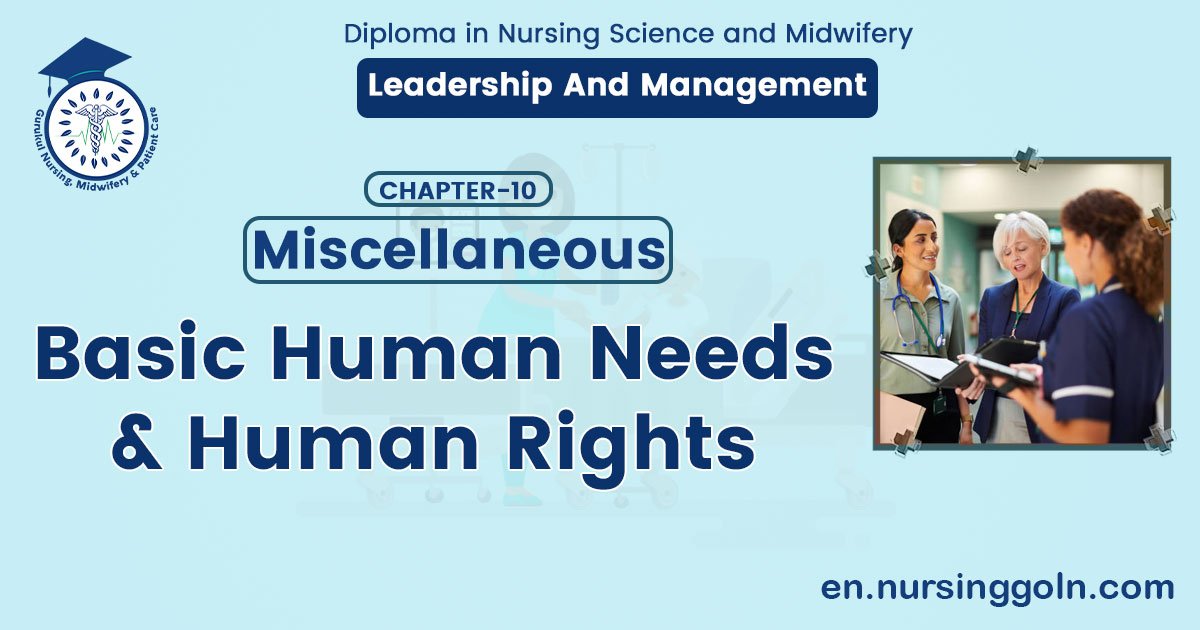Basic Human Needs and Human Rights – This book covers the entire syllabus of “Leadership & Management” prescribed by the BNMC for Diploma in Nursing Science & Midwifery Students.
We tried to accommodate latest information and topics. This book is an examination setup according to the teachers’ lectures and examination questions. At the end of the book previous university questions are given. We hope in touch with the pook students’ knowledge will be upgraded and flourished. The unique way of presentation may make your reading of the book a pleasurable experience.
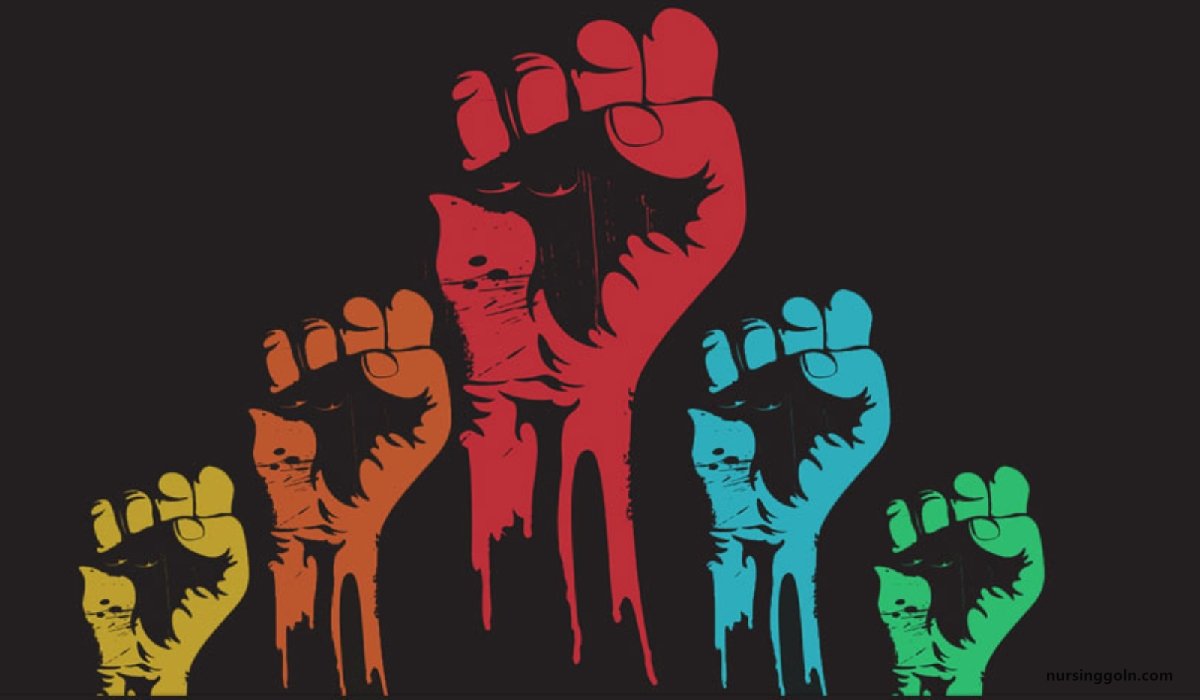
Basic Human Needs and Human Rights
Definition of Basic Human Need:
“Basic human needs” refers to those fundamental requirements that serve as the foundation for survival. Access to the basic needs of life, including shelter, food, and clothing is necessary to the development of a strong community and a necessary precursor to individual self-sufficiency.
Or,
According to Abraham Maslow “Basic human needs as a hierarchy, a progression from simple physical needs to more complex emotional needs”
Or,
A basic human need is want of something of requirement for biological psychological, social or spiritual functioning experienced by a person without which a person cannot survive.
(Ref by- SN. Nanjunde Gowda/2/69)
Or,
Basic human need is something that is essential to the emotional and physiological health and for survival of human.
Maslow’s Hierarchy of Basic Human Needs:
Abraham Maslow developed the Hierarchy of Needs model in 1940-50s USA, and the Hierarchy of Needs theory remains valid today for understanding human motivation, management training,
and personal development According to Maslow, five categories of human needs are identified and arranged in order of importance from those essential for physical survival to those necessary to develop a person’s fullest potential.
The five categories of human needs are:
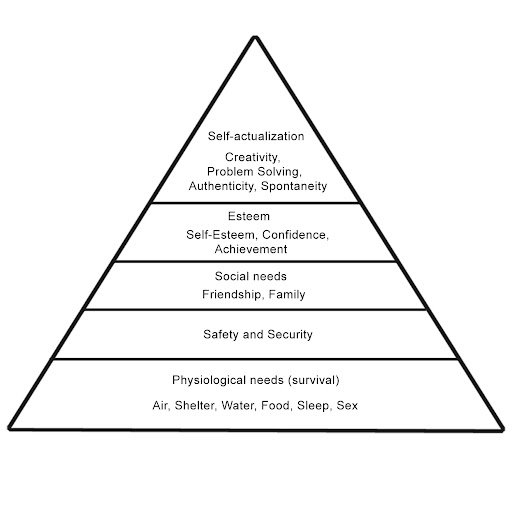
1. Physiological needs: Needs for air, nutrition, water, elimination, thermoregulation and sex.
2. Safety and security needs: Need for shelter and freedom from harm and danger.
3. Love and belonging needs (social affiliation): Need for affection feelings of belongingness and meaningful relations with others,
4. Self-esteem needs: Need to be well thought of by oneself and others.
5. Self-actualization needs: Need to be self-fulfilled, learn, create, understand and experience one’s potential.
(Ref by- SN. Nanjunde Gowda/2/69+Lecture)
Factors That Affect Basic Needs:
A. Age: New born, child youth, adult, middle aged, aged and dying.
B. Temperament, emotional state, passing mood:
a) Normal or
b) Euphoric and hyperactive
c) Anxious fearful, agitated or hysterical or
d) Depressed and hypoactive
C. Social or cultural status: A member of a family unit with friend and status, or a person relatively along and maladjusted and hypoactive.
D. Physical and intellectual capacity.
a) Normal weight
b) Underweight
c) Overweight
d) Normal mentality
e) Sub-normal mentality
f) Gifted mentality
g) Normal sense of hearing, sight, equilibrium and touch
h) Loss of special sense
i) Normal motor power
j) Loss of motor power
Characteristics of Basic Human Need:
1. Approximately same basic need.
2. The importance of each need for each person is different
3. All the Basic needs are interconnected and interactive.
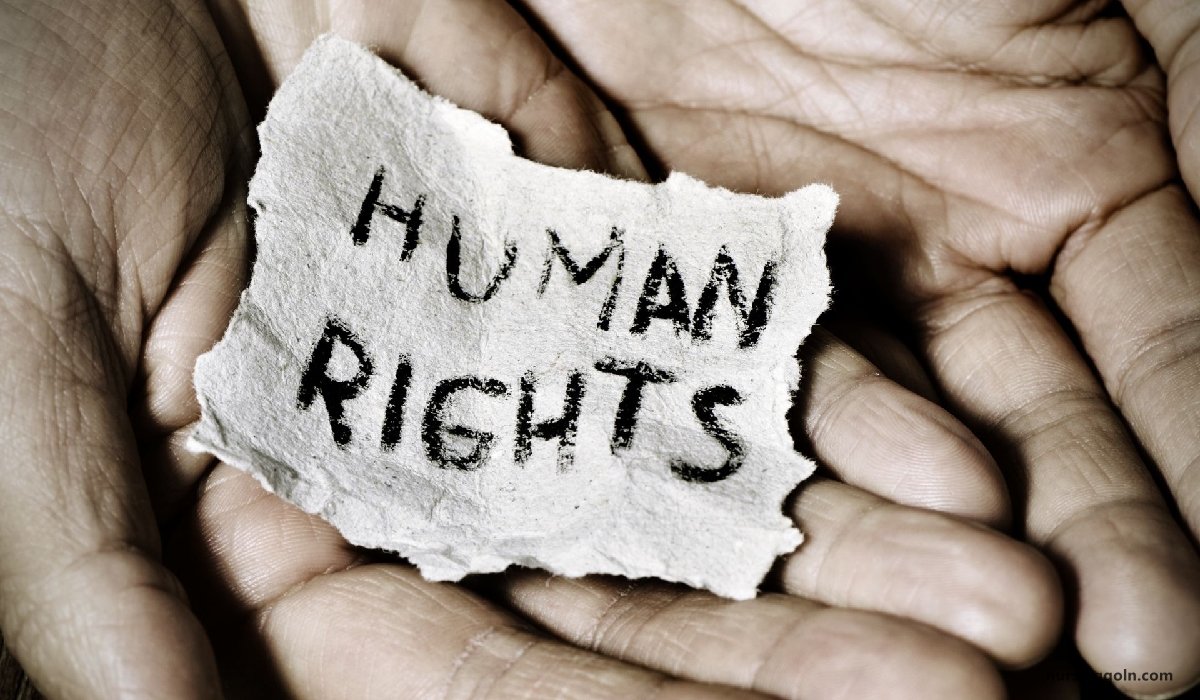
Importance/Significance of Basic Human Needs to Nursing:
1. To identify clients, unmet needs
2. To realize and understand clients words and behaviors.
3. To predict clients unspoken needs
4. To collect clients data comprehensively in case of missing
5. To put clients nursing problems in adequate order.
Pathological State Which Modifies Basic Needs:
1. Marked disturbances of fluid and electrolytic balance including starvation state, pernicious vomiting and diarrhea.
2. Shock
3. Disturbance of consciousness fainting coma, delirium.
4. Exposure to cold and heat causing markedly abnormal body temperature.
5. Acute febrile states.
6. A local injury, wound and infection
7. A communicable disease condition
8. Pre-operative state
9. Post-operative state
10. Immunization from disease or prescribed as treatment
11. Persistent or intractable pain.
(Ref by-Evolve Resources for Fundamentals of Nursing/8″ Edition)
Definition of Human Right:
According to United Nations Human Rights “Human rights are rights inherent to all human beings, whatever our nationality, place of residence, sex, national or ethnic origin, color, religion, language, or any other status”.
Or,
Human rights are moral principles or norms, which describe certain standards of human behavior, and are regularly protected as legal rights in municipal and international law.
(Ref by-en.wikipedia.org)
Or,
Human rights is the basic rights and freedoms to which all humans are considered to be entitled, often held to include the rights to life, liberty, equality, and a fair trial, freedom from slavery and torture, and freedom of thought and expression.
Types of Human Rights:
The idea of personal right is related to concern and respect for the individual member of society.
There are three types of human rights.
1. Welfare rights (Legal right): Welfare rights are rights based on a legal entitlement to some good or benefit. These rights are guaranteed by law.
2. Ethical rights (moral rights): Ethical rights are rights that are based on a moral or ethical principle.
3. Option rights: Option rights are based on the belief in the dignity and freedom of human beings. Individual rights are associated with a number of concerns. Human rights become an issue or problem when the situation may arise in which an individual is in conflict with the rights of society.
Some examples of human rights include:
- The right to life.
- The right to liberty and freedom.
- The right to the pursuit of happiness.
- The right to live your life free of discrimination.
- The right to control what happens to your own body and to make medical decisions for yourself.
(Ref by-Evolve Resources for Fundamentals of Nursing/8 Edition)
Primary Health Care
Definition of Primary Health Care (PHC)
According to WHO (World Health Organization)
“Essential health care based on practical, scientifically sound and socially acceptable methods and technology made universally accessible to individuals and families in the community through their full participation and at a cost that the community and the country can afford to maintain at every stage of their development in the spirit of self-determination”.
(Ref by-K Park/24/30)
Principle of PHC
1. Equitable Distribution
2. Community Participation
3. Intersectoral coordination
4. Appropriate Technology
A. Equitable Distribution
a) Health services must be shared equally by all people irrespective of their ability to pay.
b) Rich or poor urban or rural must have access to health services.
c) PHC services should be given according to priority of needs that the needy and vulnerable groups of the population in rural areas and urban slums.
B. Community Participation
a) Community participation is defined as the process by which individuals and families assume responsibility for their own health and welfare and fro those of the community and develop the capacity to contribute to their and the community developments.
C. Intersectoral coordination
The component of PHC cannot be provided by the health sector alone.
a) PHC involves in addition to health sector, all heath related sector
b) An important element of intersectoral approach is planning with other sectors to avoid unnecessary duplication of activities.
c) To provide adequate supply of safe water and basic sanitation of a community the coordinated approach of health department public health engineering department and information department are needed.
D. Appropriate Technology: It is
a) Scientifically sound
b) Adaptable to local needs
c) Acceptable to those who the community as well as country resources.

Definition of Comprehensive Health Care
Comprehensive health care may be defined as the provision of integrated preventive, curative and promotional health services from “womb to tomb” to every individual residing in a defined Geographic area.
Criteria, Objective, and Requirements of comprehensive health care (PHC)
| A. Criteria of comprehensive health care: |
|
| B. Objective of comprehensive health care: |
|
| C. Requirement of Comprehensive health care: |
|
Component/Element of PHC
1. Education about prevailing health problems and methods of preventing and controlling them.
2. Promotion of food supply and proper nutrition.
3. An adequate supply of safe water and basic sanitation.
4. Maternal and child health care, including family planning.
5. Immunization against infectious disease.
6. Prevention and control of endemic disease.
7. Appropriate treatment of common diseases and injuries.
8. Provision of essential drugs.
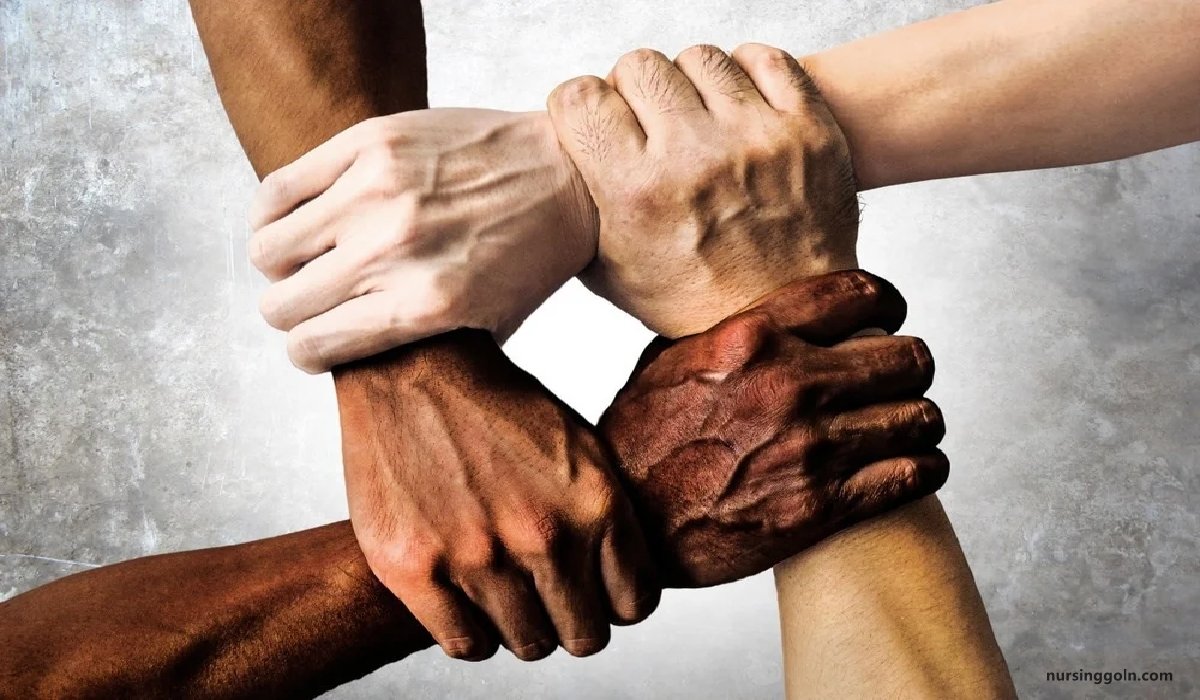
Nice To Know
Ways to Accomplish to Become a Good Nurse
(FOR SAQ)
- Authority to control its own work.
- Exclusive body of specialized knowledge.
- Extensive period of formal training.
- Control over work performance.
- Specialized competence.
- Service to society.
- Self-regulation.
- Credentialing system to certify competence.
- Legal reinforcement of professional standard,
- Ethical practice.
- Certain of a collegial sub culture.
- Intrinsic new words.
- Public acceptance.
Ways to Become a Good Nurse
| A. A body of knowledge | The of knowledge, which gives clear direction to nursing education, practice and updated by scientific knowledge, skill and attitudes. |
| B. Research and development | The professional nurse must engage in research to present theories or to generate new theories by keeping abreast of practice for the achievement of health goals |
| C. Standards of performance | Standard and criteria are measurable statements of way of a good nurse. Nursing as a profession has standard and criteria for both education and practice which used as basis for evaluation of performance. |
| D. Accountability | It means answering to someone for the quality of one’s actions. A professional nurse is accountable to herself/himself to the client to the superior/employer to the professional and to the society at large. Accountability for the knowledge that is possessed and used by the members to way of services to clients. |
| E. Professional autonomy | It means the right of self-determination and governance without external control. Autonomy is a form personal liberty of action in accordance with the plan chosen. Autonomy is given to professionals. So that the work will be done effectively by experts who in turn are competent judge of the needed expertise. |
| F. Code of Ethics | Ethics is the philosophical inquiry in to principle of mortality of right or wrong conduct. The professional conduct is guided by rules which evolve from the professional helper role and intra professional relationship. |
| G. Peer group | Collaborating and coordinating with other health care discipline to improve health care. |
Read more:
